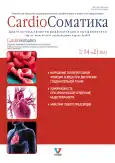Difficulties in electrocardiographic diagnosis of hyperkalemia and acute coronary syndrome: clinical case
- 作者: Fomina O.A.1, Pereverzeva K.G.1
-
隶属关系:
- Pavlov Ryazan State Medical University
- 期: 卷 14, 编号 2 (2023)
- 页面: 123-129
- 栏目: Case reports
- URL: https://journals.rcsi.science/2221-7185/article/view/146654
- DOI: https://doi.org/10.17816/CS430422
- ID: 146654
如何引用文章
全文:
详细
BACKGROUND: Clinical practice testifies to the difficulties in diagnosing hyperkalemia according to electrocardiographic (ECG) criteria during the primary contact between the doctor and the patient. This leads to the establishment of alternative diagnoses, particularly acute coronary syndrome, a delay in the implementation of measures aimed at lowering the blood potassium levels and a possible adverse outcome.
CLINICAL CASE DESCRIPTION: The article presents the clinical observation of a patient with severe hyperkalemia in the background of acute renal injury caused by mesenteric thrombosis, with ECG changes in the form of high-amplitude T wave in leads V2–V6 and induced non-sustained ventricular tachycardia. Considering the patient’s history of coronary heart disease, ECG data (high-amplitude T wave in leads V2–V6) were regarded as acute coronary syndrome with ST segment elevation. According to emergency indications, the patient underwent coronary angiography and endoprosthetics of the left circumflex artery (stenosis 99%). Upon further examination, levels of biomarkers of myocardial necrosis were slightly increased, which confirmed the established preliminary diagnosis and hyperkalemia. However, 6 h after hospitalization, the patient died. A subsequent autopsy revealed a contradiction between the clinical path and anatomical diagnosis.
CONCLUSION: This case reveals the complexity of the differential diagnosis of changes in the T wave and ST segment. Failure to promptly determine the underlying cause of these ECG changes in the presented case led to an inaccurate management strategy that negatively affects the prognosis.
作者简介
Olga Fomina
Pavlov Ryazan State Medical University
Email: ol.an.fomina@gmail.com
ORCID iD: 0000-0002-2570-7737
SPIN 代码: 5497-7231
MD, Cand. Sci. (Med.)
俄罗斯联邦, 9 Visokovoltnaya Str., 390026, RyazanKristina Pereverzeva
Pavlov Ryazan State Medical University
编辑信件的主要联系方式.
Email: pereverzevakg@gmail.com
ORCID iD: 0000-0001-6141-8994
SPIN 代码: 4995-1465
MD, Dr. Sci. (Med.), associate professor
俄罗斯联邦, 9 Visokovoltnaya Str., 390026, Ryazan参考
- Mikhailova NA. Hyperkalemia in CKD: Modern View of the Problem. Effective pharmacotherapy. 2022;18(3):30–39. (In Russ). doi: 10.33978/2307-3586-2022-18-3-30-39
- Gromov MI, Fedorov AV, Mihalchuk MA, Zaev OJ. Hyperkalaemia in the emergency diseases: practical guidelines. Emergency Medical Care. 2015;16(2):38–43. (In Russ). doi: 10.24884/2072-6716-2015-16-2-38-43
- Rafique Z, Chouihed T, Mebazaa A, Frank Peacock W. Current treatment and unmet needs of hyperkalaemia in the emergency department. Eur Heart J Suppl. 2019;21(Suppl A):A12–A19. doi: 10.1093/eurheartj/suy029
- Ajdargalieva NE, Mahmudova AK, Kuralova MB, et al. Hyperkalemia in clinical practice and its treatment. Bulletin of the Kazakh National Medical University. 2016;4:72–76. (In Russ).
- Gupta AA, Self M, Mueller M, et al. Dispelling myths and misconceptions about the treatment of acute hyperkalemia. Am J Emerg Med. 2022;52:85–91. doi: 10.1016/j.ajem.2021.11.030
- Durfey N, Lehnhof B, Bergeson A, et al. Severe hyperkalemia: can the electrocardiogram risk stratify for short-term adverse events? West J Emerg Med. 2017;18(5):963–971. doi: 10.5811/westjem.2017.6.33033
- Rafique Z, Weir MR, Onuigbo M, et al. Expert Panel Recommendations for the Identification and Management of Hyperkalemia and Role of Patiromer in Patients with Chronic Kidney Disease and Heart Failure. J Manag Care Spec Pharm. 2017;23(4-a Suppl):S10–S19. doi: 10.18553/jmcp.2017.23.4-a.s10
- Wrenn KD, Slovis CM, Slovis BS. The ability of physicians to predict hyperkalemia from the ECG. Ann Emerg Med. 1991;20(11):1229–1232. doi: 10.1016/s0196-0644(05)81476-3
- Martindale J, deSouza IS. Managing pacemaker-related complications and malfunctions in the emergency department. Emerg Med Pract. 2014;16(9):1–21;quiz 21–22.
- Sovari AA, Assadi R, Lakshminarayanan B, Kocheril AG. Hyperacute T wave, the early sign of myocardial infarction. Am J Emerg Med. 2007;25(7):859.e1–859.e7. doi: 10.1016/j.ajem.2007.02.005
- Peerbhai S, Masha L, DaSilva-DeAbreu A, Dhoble A. Hyperkalemia masked by pseudo-stemi infarct pattern and cardiac arrest. Int J Emerg Med. 2017;10(1):3. doi: 10.1186/s12245-017-0132-0
- Parshikova EN, Filippov EV. Variations in all-cause mortality in patients with myocardial infarction with elevation of the ST segment according to the type of reperfusion therapy received (data of Ryazan region, 2018–2020). I.P. Pavlov Russian Medical Biological Herald. 2020;28(4):479–487. (In Russ). doi: 10.23888/PAVLOVJ2020284479-487
- Sergeev AN, Morozov AM, Kadykov VA, et al. Treatment of mesenteric thrombosis in the aspect of early thrombectomy from mesenteric artery. Science of the Young (Eruditio Juvenium). 2020;8(2):303–311. (In Russ). doi: 10.23888/HMJ202082303-311
补充文件









